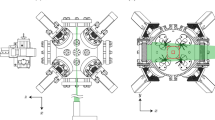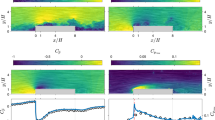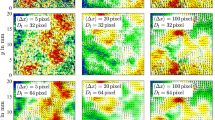Abstract
Measuring the turbulent kinetic energy dissipation rate in an enclosed turbulence chamber that produces zero-mean flow is an experimental challenge. Traditional single-point dissipation rate measurement techniques are not applicable to flows with zero-mean velocity. Particle image velocimetry (PIV) affords calculation of the spatial derivative as well as the use of multi-point statistics to determine the dissipation rate. However, there is no consensus in the literature as to the best method to obtain dissipation rates from PIV measurements in such flows. We apply PIV in an enclosed zero-mean turbulent flow chamber and investigate five methods for dissipation rate estimation. We examine the influence of the PIV interrogation cell size on the performance of different dissipation rate estimation methods and evaluate correction factors that account for errors related to measurement uncertainty, finite spatial resolution, and low Reynolds number effects. We find the Re λ corrected, second-order, longitudinal velocity structure function method to be the most robust method to estimate the dissipation rate in our zero-mean, gaseous flow system.












Similar content being viewed by others
Abbreviations
- A :
-
constant, from the scaling argument method
- B :
-
spatial spectral-filtering function
- C 1 :
-
first Kolmogorov constant
- C 2 :
-
second Kolmogorov constant
- C 3 :
-
third Kolmogorov constant
- C s :
-
Smagorinsky constant
- \(D_{L^n}\) :
-
longitudinal velocity structure function of order n
- D LL :
-
second-order longitudinal velocity structure function
- D LLL :
-
third-order longitudinal velocity structure function
- D NN :
-
second-order transverse velocity structure function
- E :
-
three-dimensional energy spectrum
- E 11(κι):
-
one-dimensional energy spectrum
- L :
-
large eddy length scale
- L 11 :
-
longitudinal integral length scale
- N :
-
number of points for the Fourier transform of the velocity vector field
- Re λ :
-
Taylor microscale Reynolds number
- T e :
-
large eddy time scale
- f(r):
-
longitudinal velocity spatial correlation function
- h :
-
height of PIV interrogation volume
- k :
-
turbulent kinetic energy
- r :
-
three-dimensional direction vector
- r i :
-
velocity vector separation in x i direction
- \( \underline{{\overset{\lower0.5em\hbox{$\smash{\scriptscriptstyle\frown}$}}{r} }} \) :
-
unit vector in the r direction
- r IR :
-
inertial range velocity vector separation in x i direction
- s ij :
-
fluctuating rate-of-strain tensor
- \( \tilde{s}_{ij} \) :
-
filtered fluctuating rate-of-strain tensor
- t η :
-
Kolmogorov time scale
- u :
-
instantaneous velocity vector at a point
- u i :
-
instantaneous velocity vector at a point in the x i direction
- u′ :
-
root mean square of the velocity fluctuations
- \( u_{i}^{\prime } \) :
-
root mean square of the velocity fluctuations in the x i direction
- \( \tilde{u}_{i} \) :
-
filtered root mean square of the velocity fluctuations in the x i direction
- \( \overset{\lower0.5em\hbox{$\smash{\scriptscriptstyle\frown}$}}{u}_{j} \) :
-
Fourier transform of the velocity vector field
- \( \overset{\lower0.5em\hbox{$\smash{\scriptscriptstyle\frown}$}}{u}_{j}^{*} \) :
-
complex conjugate Fourier transform of the velocity vector field
- u η :
-
Kolmogorov velocity scale
- w :
-
width of PIV interrogation volume
- x :
-
three-dimensional position vector
- Δx i :
-
separation between PIV vectors
- Δ:
-
“window” size over which velocity field is spatial averaged
- Φ ij :
-
three-dimensional velocity spectrum tensor
- α :
-
proportionality constant for the Lin spectrum
- ε :
-
turbulent kinetic energy dissipation rate
- η :
-
Kolmogorov length scale
- κ :
-
wavenumber vector
- κ :
-
magnitude of wavenumber vector
- κ i :
-
wavenumber in x i direction
- κ i, IR :
-
inertial subrange wavenumbers in x i direction
- Δκ 1 :
-
separation between wavenumbers
- ν :
-
kinematic viscosity
- τ :
-
depth of PIV interrogation volume
- τ ij :
-
subgrid Reynolds stress
References
Antonia RA, Burattini P (2006) Approach to the 4/5 law in homogeneous isotropic turbulence. J Fluid Mech 550:175–184
Baldi S, Yianneskis M (2003) On the direct measurement of turbulence energy dissipation in stirred vessels with PIV. Ind Eng Chem Res 42:7006–7016
Batchelor GK, Townsend AA (1948) Decay of isotropic turbulence in the initial period. Proc R Soc Lond A Math Phys Sci 193:539
Benedict LH, Gould RD (1996) Towards better uncertainty estimates for turbulence statistics. Exp Fluids 22:129–136
Birouk M, Chauveau C, Sarh B, Quilgars A, Gokalp I (1996) Turbulence effects on the vaporization of monocomponent single droplets. Combust Sci Technol 113–114:413–428
Birouk M, Sarh B, Gokalp I (2003) An attempt to realize experimental isotropic turbulence at low Reynolds number. Flow Turbul Combust 70:325–348
Boivin M, Simonin O, Squires KD (1998) Direct numerical simulation of turbulence modulation by particles in isotropic turbulence. J Fluid Mech 375:235–263
Burattini P, Lavoie P, Antonia RA (2005) On the normalized turbulent energy dissipation rate. Phys Fluids 17:098103
Canuto VM, Cheng Y (1997) Determination of the Smagorinsky-Lilly constant Cs. Phys Fluids 9:1368–1378
Chen S, Doolen G, Herring J, Kraichnan RH, Orszag SA, She ZS (1993) Far-dissipation range of turbulence. Phys Rev Lett 70:3051–3054
Chen J, Meneveau C, Katz J (2006) Scale interactions of turbulence subjected to a straining-relaxation-destraining cycle. J Fluid Mech 562:123–150
Clark RA, Ferziger JH, Reynold WC (1979) Evaluation of subgrid-scale models using accurately simulated turbulent flow. J Fluid Mech 91:1–16
Comte-Bellot G, Corrsin S (1971) Simple Eulerian time correlation of full and narrow-band velocity signals in grid generated, ‘isotropic’ turbulence. J Fluid Mech 48:273–337
Danaila L, Anselmet F, Zhou T, Antonia RA (1999) A generalization of Yaglom’s equation which accounts for the large-scale forcing in heated decaying turbulence. J Fluid Mech 391:359–372
Druzhinin OA, Elghobashi S (1999) On the decay rate of isotropic turbulence laden with microparticles. Phys Fluids 11:602–610
Ducci A, Yianneskis M (2005) An analysis in the measurement of energy dissipation with two point LDA. Exp Fluids 38:449–460
Eidelman A, Elperin T, Kleeorin N, Rogachevskii I, Sapir-Katiraie I (2006) Turbulent thermal diffusion in a multi-fan turbulence generator with imposed mean temperature gradient. Exp Fluids 40:744–752
Etebari A, Vlachos PP (2005) Improvements on the accuracy of derivative estimation from DPIV velocity measurements. Exp Fluids 39:1040–1050
Ewing D, Hussein HJ, George WK (1995) Spatial resolution of parallel hot-wire probes for derivative measurements. Exp Therm Fluid Sci 22:155–173
Fallon T, Rogers CB (2002) Turbulence induced preferential concentration of solid particle in microgravity conditions. Exp Fluids 33:233–241
Fansler TD, Groff EG (1990) Turbulence characteristics of a fan-stirred combustion vessel. Combust Flame 80:350–354
Foucaut JM, Stanislas M (2002) Some considerations on the accuracy and frequency response of some derivative filters applied to particle image velocimetry vector fields. Meas Sci Technol 13:1058–1071
Foucaut JM, Carlier J, Stanislas M (2004) PIV optimization for the study of turbulent flow using spectral analysis. Meas Sci Technol 15:1046–1058
Fouras A, Sorla J (1998) Accuracy of out-of-plane vorticity measurements derived from in-plane velocity field data. Exp Fluids 25:409–430
Gagne Y, Castaing B, Baudet C, Malecot Y (2004) Reynolds dependence of third-order velocity structure functions. Phys Fluids 16:482–485
Gotoh T, Fukayama D, Nakano T (2002) Velocity field statistics in homogeneous steady turbulence obtained using a high-resolution direct numerical simulation. Phys Fluids 14:1065–1081
Groff EG (1987) An experimental evaluation of an entrainment flame-propagation model. Combust Flame 67:153–162
Hinze JO (1975) Turbulence. McGraw-Hill, New York
Hwang W, Eaton JK (2004) Creating homogeneous and isotropic turbulence without a mean flow. Exp Fluids 36:444–454
Hwang W, Eaton JK (2006) Homogeneous and isotropic turbulence modulation by small heavy (St 50) particles. J Fluid Mech 564:361–393
Kholmyansky M, Moriconi L, Tsinober A (2007) Large scale intermittency in the atmospheric boundary layer. Phys Rev E Stat Nonlin Soft Matter Phys 76:026307
Kline SJ, McClintock FA (1953) Describing uncertainties in single-sample experiments. Mech Eng 75:3–8
Kolmogorov AN (1941a) The local structure of turbulence in an incompressible viscous fluid for very large Reynolds numbers. Dokl Akad Nauk SSSR 30:299–303
Kolmogorov AN (1941b) Dissipation of energy in locally isotropic turbulence. Dokl Akad Nauk SSSR 32:16–18 Reprinted in 1991, Proc R Soc Lond A Math Phys Sci 434:15
Kwon S, Wu M-S, Driscol JF, Faeth GM (1992) Flame surface properties of premixed flames in isotropic turbulence: measurements and numerical simulations. Combust Flame 88:221–238
Lavoie P, Avallone G, De Gregorio F, Romano GP, Antonia RA (2007) Spatial resolution of PIV for the measurement of turbulence. Exp Fluids 43:39–51
Lecordier B, Demare D, Vervisch LMJ, Reveillon J, Trinite M (2001) Estimation of the accuracy of PIV treatments for turbulent flow studies by direct numerical simulation of multi-phase flow. Meas Sci Technol 12:1382–1391
Lele SK (1992) Compact finite difference schemes with spectral-like resolution. J Comput Phys 103:16–42
Lilly DK (1967) The representation of small-scale turbulence in numerical simulation experiments. In: Goldstein HH (ed) Proceedings of the IBM scientific computing symposium on environmental science. IBM, New York, pp 195–201
Lin J (1972) Velocity spectrum of locally isotropic turbulence in the inertial and dissipation ranges. Phys Fluids 15:205–207
Liu S, Meneveau C, Katz J (1994) On the properties of similarity subgrid-scale models as deduced from measurements in a turbulent jet. J Fluid Mech 275:83
Liu S, Katz J, Meneveau C (1999) Evolution and modeling of subgrid scales during rapid straining of turbulence. J Fluid Mech 387:281–320
Martinez DO, Chen S, Doolen GD, Kraichnan RH, Wang L-P, Zhou Y (1997) Energy spectrum in the dissipation range of fluid turbulence. J Plasma Phys 57:195–201
Meneveau C, Katz J (2000) Scale-invariance and turbulence models for large-eddy simulation. Annu Rev Fluid Mech 32:1–32
Meng H, Pan G, Pu Y, Woodward SH (2004) Holographic particle image velocimetry: from film to digital recording. Meas Sci Technol 15:673–685
Mi J, Antonia RA (1994) Some checks of Taylor’s hypothesis in a slightly heated turbulent circular jet. Exp Therm Fluid Sci 8:328–335
Moisy F, Tabeling P, Willaime H (1999) Kolmogorov equation in fully developed turbulence experiment. Phys Rev Lett 82:3994–3997
Mydlarski L, Warhaft Z (1996) On the onset of high-Reynolds-number grid-generated wind tunnel turbulence. J Fluid Mech 320:331–368
Poelma C, Westerweel J, Ooms G (2006) Turbulence statistics from optical whole-field measurements in particle laden turbulence. Exp Fluids 40:347–363
Pope SB (2000) Turbulent flows. Cambridge University Press, Cambridge
Qian J (1997) Inertial range and the finite Reynolds number effect of turbulence. Phys Rev E Stat Nonlin Soft Matter Phys 55:337–342
Qian J (1999) Slow decay of the finite Reynolds number effect of turbulence. Phys Rev E Stat Phys Plasmas Fluids Relat Interdiscip Topics 60:3409–3412
Saarenrinne P, Piirto M (2000) Turbulent kinetic energy dissipation rate estimate from PIV velocity vector fields. Exp Fluids 29:(Suppl) S300–S307
Saarenrinne P, Piirto M, Eloranta H (2001) Experiences of turbulence measurement with PIV. Meas Sci Technol 12:1904–1910
Salazar JPLC, de Jong J, Cao L, Woodward SH, Meng H, Collins LR (2008) Experimental and numerical investigation of inertial particle clustering in isotropic turbulence. J Fluid Mech 600:245–256
Sanada T (1992) Comment on the dissipation-range spectrum in turbulent flows. Phys Fluids A 4:1086–1087
Sheng J, Meng H, Fox RO (2000) A large eddy PIV method for turbulence dissipation rate estimation. Chem Eng Sci 55:4423–4434
Sirovich L, Smith L, Yakhot V (1994) Energy spectrum of homogeneous and isotropic turbulence in far dissipation range. Phys Rev Lett 72:344–347
Smagorinsky J (1963) General circulation experiments with the primitive equations: 1. The basic experiment. Mon Weather Rev 91(3):99–162
Smith LM, Reynolds WC (1991) The dissipation-range spectrum and the velocity-derivative skewness in turbulence flows. Phys Fluids A 3:992–994
Sreenivasan KR (1984) On the scaling of the energy dissipation rate. Phys Fluids 27:1048
Sreenivasan KR (1995) On the universality of the Kolmogorov constant. Phys Fluids 7:2778–2784
Sreenivasan KR (1998) An update on the energy dissipation rate in isotropic turbulence. Phys Fluids 10:528–529
Sundaram S, Collins LR (1999) A numerical study of the modulation of isotropic turbulence by suspended particles. J Fluid Mech 379:105–143
Sveen JK (2004) An introduction to MatPIV 1.6.1. Department of Mathematics, University of Oslo, Oslo. [Eprint no. 2, ISSN 0809–4403]
Tanaka T, Eaton JK (2007) A correction method for measuring turbulence kinetic energy dissipation rate by PIV. Exp Fluids 42:893–902
Taylor GI (1938) The spectrum of turbulence. Proc R Soc Lond A Math Phys Sci 164:476–490
van Hout R, Zhu W, Luznik L, Katz J, Kleissl J, Parlange MB (2007) PIV measurement in the atmospheric boundary layer within and above and mature corn canopy. Part 1: statistics and energy flux. J Atmos Sci 64:2805–2824
Variano EA, Cowen EA (2008) A random-jet-stirred turbulence tank. J Fluid Mech 604:1–32
Videto BD, Santavicca DA (1991) A turbulent flow system for studying turbulent combustion processes. Combust Sci Technol 76:159–164
von Kármán T, Howarth L (1938) On the statistical theory of isotropic turbulence. Proc R Soc Lond A Math Phys Sci 164:192–215
Voth GA, La Porta A, Crawford AM, Alexander J, Bodenschatz E (2002) Measurement of particle accelerations in fully developed turbulence. J Fluid Mech 469:121–160
Wang G-H, Clemens NT, Barlow RS, Varghese PL (2007) A system model for assessing scalar dissipation measurement accuracy in turbulent flows. Meas Sci Technol 18:1287–1303
Webster DR, Brathwaite A, Yen J (2004) A novel laboratory apparatus for simulating isotropic oceanic turbulence at low Reynolds numbers. Limnol Oceanogr Methods 2:1–22
Wood AM, Hwang W, Eaton JK (2005) Preferential concentration of particles in homogeneous and isotropic turbulence. Int J Multiphase Flow 31:1220–1230
Wyngaard JC (1968) Measurement of small-scale turbulence structure with hot wires. J Sci Instrum 1:1105–1108
Wyngaard JC (1969) Spatial resolution of the vorticity meter and other hot-wire arrays. J Sci Instrum 2:983–987
Wyngaard JC (1971) Spatial resolution of a resistance wire temperature sensor. Phys Fluids 14:2052–2054
Yeung PK, Zhou Y (1997) Universality of the Kolmogorov constant in numerical simulation of turbulence. Phys Rev E Stat Nonlin Soft Matter Phys 56:1746–1752
Zeff BW, Lanterman DD, McAllister R, Roy R, Kostelich EJ, Lathrop DP (2003) Measuring intense rotation and dissipation in turbulent flows. Nature 421:146–149
Zhou T, Antonia RA (2000) Reynolds number dependence of the small-scale structure of grid turbulence. J Fluid Mech 406:81–107
Zhou T, Antonia RA, Danaila L, Anselmet F (2000) Approach to the four-fifths ‘law’ for grid turbulence. J Turbul 1(1):1–12
Zhu W, van Hout R, Katz J (2007) On the flow structure and turbulence during sweep and ejection events in a model canopy. Bound Layer Metrol 124:205–233
Acknowledgments
This work was supported by the NASA Microgravity Fluid Physics Program grants NNCO5GA45G and NNCO5GA37G, by the National Science Foundation through grants CTS-0112514 and PHY-0554675, and by the New York State Office of Science, Technology and Academic Research (NYSTAR) under contract number 3538479. J.P.L.C. Salazar acknowledges support from the Brazilian Ministry of Education through the CAPES agency.
Author information
Authors and Affiliations
Corresponding author
Rights and permissions
About this article
Cite this article
de Jong, J., Cao, L., Woodward, S.H. et al. Dissipation rate estimation from PIV in zero-mean isotropic turbulence. Exp Fluids 46, 499–515 (2009). https://doi.org/10.1007/s00348-008-0576-3
Received:
Revised:
Accepted:
Published:
Issue Date:
DOI: https://doi.org/10.1007/s00348-008-0576-3




